Grape mildew: a description of the disease, when and how to treat downy mildew
Mildew or downy mildew is the most dangerous and widespread fungal disease of grapes, which became known at the end of the 19th century. It was then that it was brought to France from North America, and it was then that there was a sharp decline in viticulture in all regions of Europe. From here it becomes quite clear that if you do not wage a stubborn and thorough struggle with it, then it will cause considerable damage to the harvest and the grape bushes themselves in your summer cottage.
You can read about the causes of the disease, about measures of prevention and treatment, as well as about the types of drugs used in the fight against grape mildew, you can read in our article.
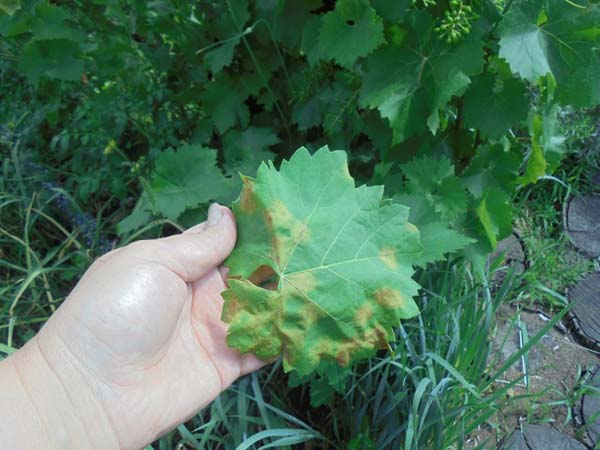
Content
- 1 Description and causes of the disease: what is the danger of mildew on grapes and how it manifests itself
- 2 Agrotechnical measures for the control and prevention of mildew (downy mildew)
- 3 When to treat grapes from mildew: spraying scheme
- 4 How to treat grapes from mildew: preparations for downy mildew
Description and causes of the disease: what is the danger of mildew on grapes and how it manifests itself
As well as oidium, mildew (downy mildew) poses no less, and perhaps even a greater threat to the future grape harvest in the garden.
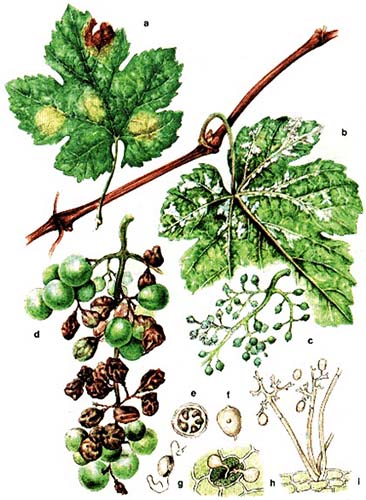
Fungal spores overwinter in fallen leaves and berries.
Mildew on grapes appears on all green parts of the bush: shoots, leaves, inflorescences, berries.
If on face of leaves you see oily (yellow) spots, a on the reverse side - a whitish powdery coatingso to speak white fluff (in place of the spot), then this is a clear sign of the disease.
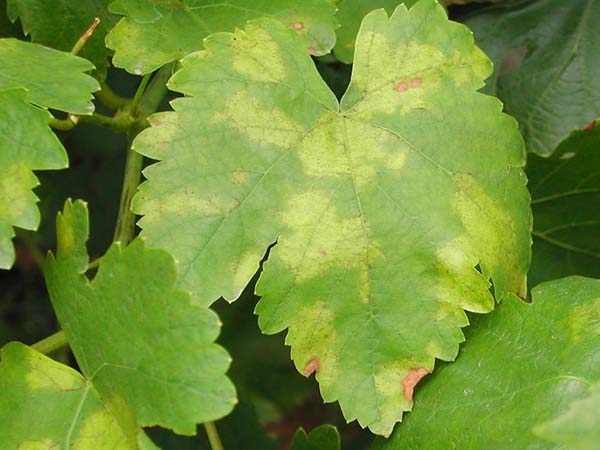
As a rule, the fungus gets on the grapes (on its leaves) with the first spring rain. The fact is that for the germination of fungal spores, free moisture (water film) is needed.
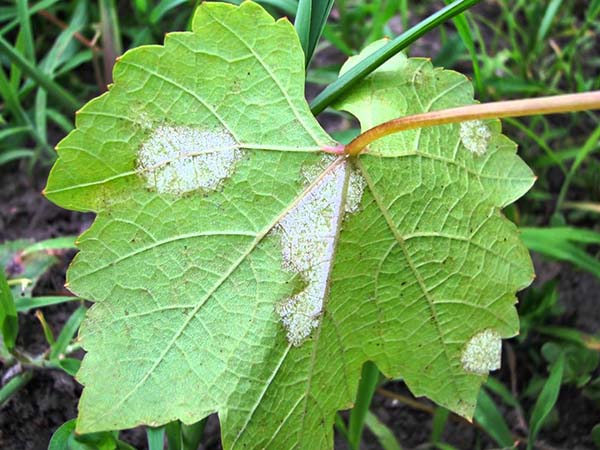
Then the fungus spreads to the shoots and finally to the brushes (berries).
As a result, the leaves of the grapes dry up, die off and crumble. The tops of the shoots of grapes also dry up, and the grapes themselves (fruits) actively wither (first, their color becomes bluish, and then brown) and shrivel, thereby forming the so-called "leathery berries".
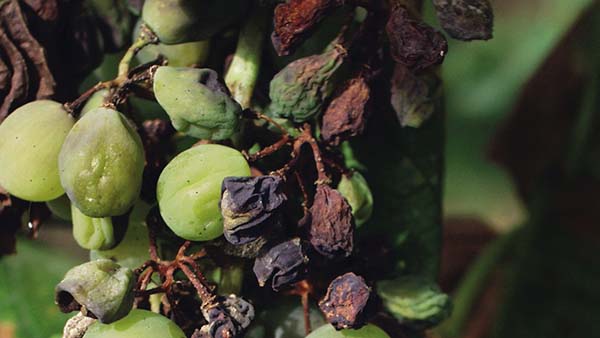
The main reason, or rather, the most favorable conditions for the occurrence of mildew on grapes is high humidity (2-3 days of rain) and air temperature from +10 to +30 degrees (spring rains).
By the way! At temperatures below +10 and above +30 degrees, the fungus does not work.
Video: mildew is a dangerous grape disease
Agrotechnical measures for the control and prevention of mildew (downy mildew)
As a rule, mildew mainly affects young grape foliage, which has not yet developed sufficient immunity, besides, the older one was treated in early spring during preventive spraying, so it is worth regularly promptly getting rid of all young stepchildren (pinch the grapes), and also carry out chasing shoots (summer pruning of grapes).
This way you can reduce the chance of getting mildew. improving the airflow rate of the bush, which will have a positive effect on drying it after rain, because it is during periods of high humidity that the disease spreads most of all.
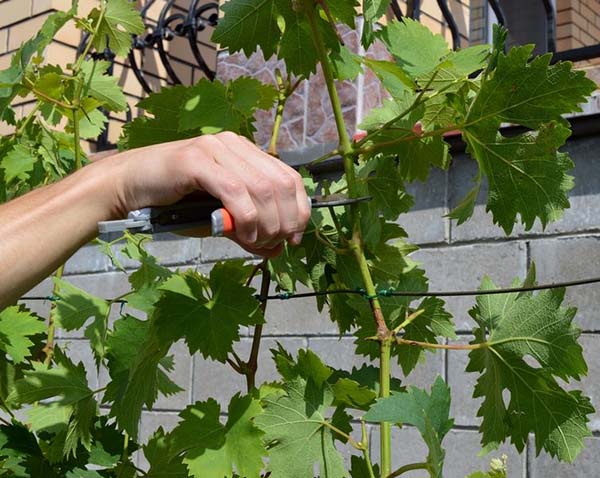
Advice! Some growers, so that the grapes do not suffer so much from rains, and as a result, do not actively develop mildew on it, do over the bushes a special visor or canopy.
But it is worthwhile to understand that in the morning dew will still accumulate, and the air will partly stagnate under the visor itself.
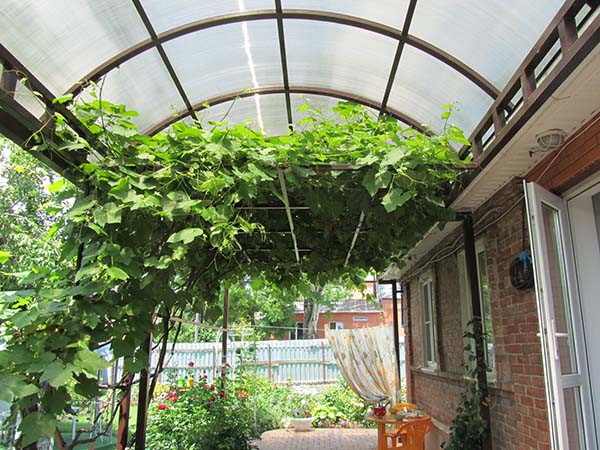
Note! Very important do not leave torn diseased leaves and vines under grape bushes, since they can easily become breeding grounds for infection next year (mildew will easily overwinter in them).
This also applies to general cleaning and preparing grapes for winter after harvest. All affected leaves and shoots (after autumn pruning) follows burn immediately, but under no circumstances should be thrown onto the compost heap or buried.
Video: how to treat grapes for mildew
Disease resistant varieties
Naturally, if you do not want to constantly be engaged in spraying and processing your vineyards, then you need to initially plant resistant varieties that are immune to fungal diseases.
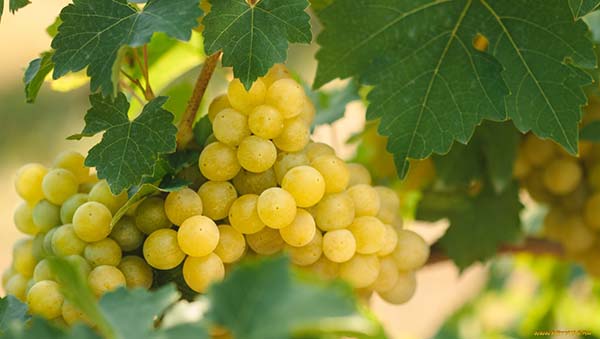
As a rule, grape varieties, depending on their resistance to diseases, are classified according to the 5 point school: 0 - complete immunity, 1 - high resistance, 2 - resistance, 3 - tolerance, 4 - susceptibility and 5 - the most unstable (very high susceptibility).
Important! It is still necessary to process even resistant (2) grape varieties, only the number of such spraying is less and the damage, as a rule, is not as widespread as in very susceptible ones (5).
The most powerful grape varieties related to 1-3 degrees of resistance are: Victoria, Friendship, December, Khasansky Bousa, Khasansky sweet, Pearl pink, Super Extra, Bianca, Citron Magaracha, Supaga, Somerset Sidlis, King of the North, Valiant, Vitis Riparia and many others.
When to treat grapes from mildew: spraying scheme
In order to prevent the appearance of mildew on grapes, you need to process the bushes several times in the spring.
Interesting! Before against mildewused only various copper-containing agents (like copper sulfate, bordeaux liquid), but now much more modern drugs have appeared.
The scheme for processing grapes from downy mildew involves several sprays, with the most important ones being 1, 2 and 4 (they can be called preventive):
- 1. After removing the shelter and garter (along the bare branches), it is optimal to use contact means (protective), since the spores of the fungus have not yet penetrated deep into the plant. Moreover, it is necessary to process not only the vine, but also the soil under it.
- 2. Before flowering (after the appearance of the first 3-4 leaves) - systemic preparations (protective) are used. Moreover, it is desirable to have time to carry out 2 treatments (according to some winegrowers, the first can be carried out with a contact drug, and the second must be systemic).
- 3. During flowering - systemic agents should also be used, but if possible without copper (some varieties do not react well to such spraying).
Processing should only be carried out if if the weather is unfavorable and very high humidity (it rains).
If the weather is dry, then you do not need to spray.
- 4. After flowering, but until berries the size of a "pea" (if you notice signs of the disease), it is possible to use systemic drugs (treating), but in a lower concentration, or it is better to switch to the use of biological products.
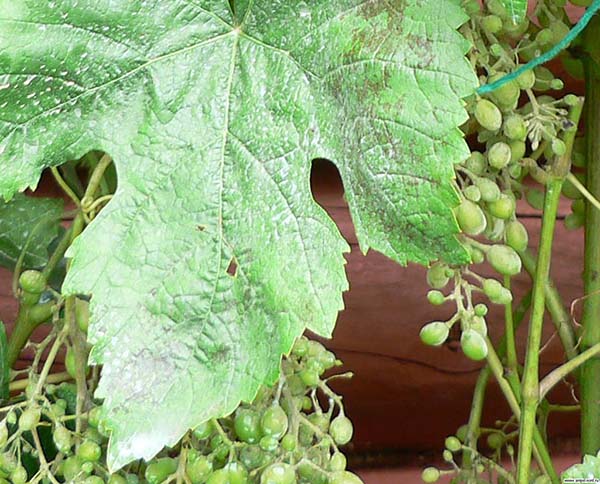
- 5. During fruiting, but before harvesting - if the first 4 treatments did not help (usually they are enough), then it is now desirable to use only biological products or those systemic drugs that have a minimum (short) waiting period. In this case, treatments are carried out every 1-2 weeks or after each rain.
- 6. After harvest (autumn eradication treatment).
By the way! It is believed that for prevention (if there are no signs of disease), less concentrated spray solutions can be used.
Video: mildew grape disease - methods and scheme of struggle
How to treat grapes from mildew: preparations for downy mildew
Mildew is a rather insidious and dangerous disease, so it can be very difficult to remove it. But it is quite possible to do this using a variety of means of struggle. Folk remedies, as well as more modern and effective chemical and biological preparations, will help you with this in the best possible way.
How to determine the type of drug to use
Naturally, it is fundamentally important to be able to determine, by the state of your grapes, which drug should be used.
Note! Fungicides are divided into systemic and contact, as well as therapeutic and protective (prophylactic).
- If you have recently sprayed grapes, leaves are clean, no signs of disease, it is best to use preventive (protective) drugs.
- If you noticed the first signs of illness, even if only on some leaves, then you already need to apply medicinal drugs.
As a rule, many drugs are protective and therapeutic action.
- Systemic drugs Are "absorbed" by the plant and act from the inside, and by and large it is not very important to process the entire leaf surface. Also, some systemic drugs transfer their active substance to the tops of the vines, thus protecting the growing points from diseases.
Moreover, most drugs are systemic contact action.
- Contact drugs work only where you put them. Therefore, where you do not apply them, the disease will remain, it will not go anywhere. That is why such processing must be done very carefully.
But you should not overdo it either, since the preparations themselves often have an important recommendation "Do not let the liquid run off the sheet."
Thus, when choosing a drug to combat mildew, you must carefully study its instructions.
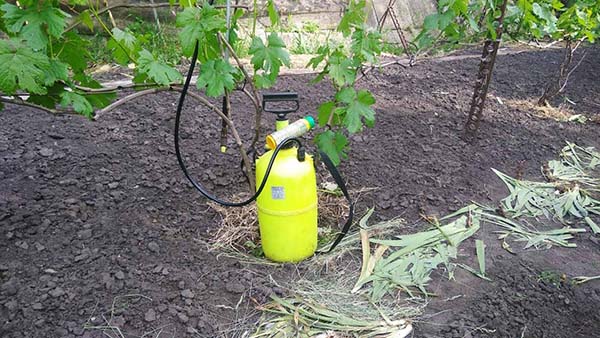
Rules for the use of fungicides:
- When processing, be sure to alternate means, and it is necessary that not only change the name of the drug, namely the active substance. This is the only way you can prevent addiction (resistance) of the pathogen to the substance itself.
- Fungus actively developing in damp warm weather, so processing contact drugs need to do after every rain... Actually, all the main outbreaks of mildew occur at this very moment.
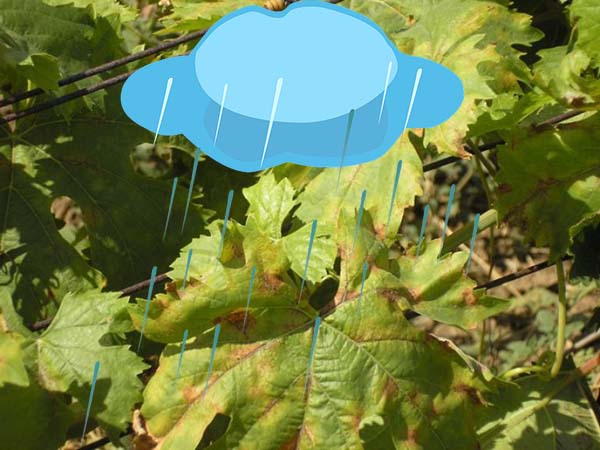
- Handling strong systemic drugs recommended in the early stages of grape development, maximum to the size of a pea berry... In the future, it is recommended to use products with a shorter waiting period (as an option, biological products).
- Understand that you were able to defeat mildew, you can according to the state of the leaves. If the grape leaves look like in the photo (the white fluff at the back of the leaf should turn brown or gray, and the lesion should dry out), this means that the fungus has died.
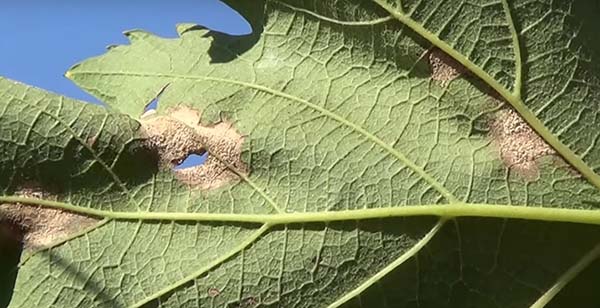
Chemicals
If you notice clear initial signs of damage, then chemical preparations will be most effective.
Important! Before buying and using the drug, be sure to carefully read the instructions.
Most Popular systemic preparations for the treatment of grapes from mildew (active ingredients are given in brackets):
- Strobe (Kresoxim-methyl, systemic fungicide of protective and curative action);
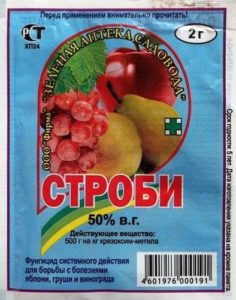
- Consento (Propamocarb hydrochloride and Fenamidone, systemic fungicide of protective action);
- Alet (Fosetyl aluminum, a systemic protective fungicide).
System contact:
- Quadris (Azoxystrobin, systemic contact protective fungicide);
There is also Quadris Top (Azoxystrobin + Difenoconazole).
- Bellis (Boscalid and Piraklostrobin, systemic contact fungicide of protective action);
- Signum (Boscalid and Pyraclostrobin, systemic contact fungicide of protective action);
- Revus Top (Difenoconazole + Mandipropamide, systemic contact fungicide of protective-treating action);
There is also just a Revus (Mandipropamide), a systemic fungicide of protective-curative action.
- Profit Gold (Famoxadone + Cymoxanil, systemic contact fungicide of protective-treating action);
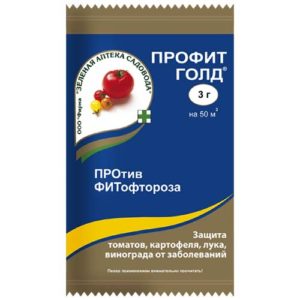
Analogs - Thanos, Ulysses.
- Acrobat Top (Dimethomorph + Dithianon, systemic contact fungicide of protective-treating action);
- Acrobat MC (Mancozeb + Dimethomorph, systemic contact fungicide of protective-treating action);
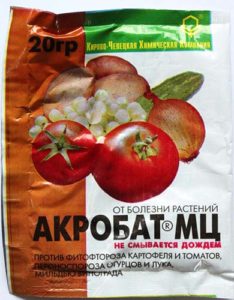
- Ridomil Gold MC (Mancozeb + Mefenoxam, systemic contact fungicide of protective and therapeutic action);
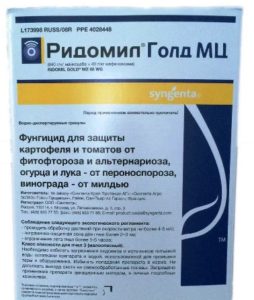
- Ridomil MC (Mancozeb + Metalaxil, systemic contact fungicide of protective and therapeutic action);
Analogs - Acidan, Metaxil, Metamil MC.
- Ordan MC (Mancozeb + Cymoxanil, systemic contact fungicide of protective and therapeutic action);
Analog - Rapid Gold.
- Cuprolux (Copper oxychloride + Cymoxanil, systemic contact fungicide of protective and therapeutic action).
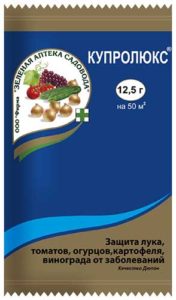
Analogs - Kurzat R, Ordan, Broneks.
- Oxyhom (Copper oxychloride + Oxadixil, systemic contact fungicide of protective action);
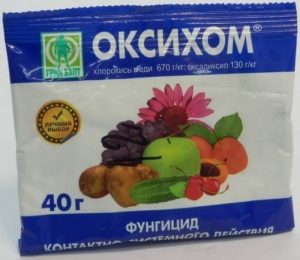
Analogs - Homoxil, Proton Extra.
- Tsikhom (Copper oxychloride + Tsineb, systemic contact fungicide of protective action).
Analog - Kuprozan.
- Pergado M (Copper oxychloride and Mandipropamide, systemic contact fungicide of protective-curative action).
Contact preparations for mildew (they are usually used before flowering for prophylactic purposes, when there are no signs of the disease):
- Ditan M-45 (Mancozeb, contact fungicide of protective action);
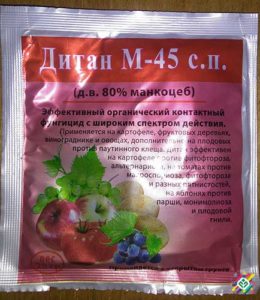
- Delan (Dithianon, contact fungicide of protective action);
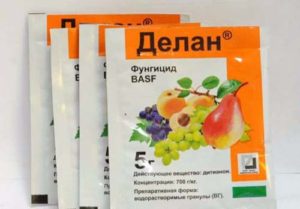
- Cabrio top (Pyraclostrobin + Metiram (Polycarbocin), contact fungicide of protective action);
- Poliram DF (Metiram (Polycarbocin), contact fungicide of protective action);
- Polychom (Copper oxychloride and Metiram (Polycarbocin), contact fungicide of protective action);
- Buzzer (Fluazinam, contact fungicide of protective action);
- Tersel (Dithianon and Pyraclostrobin, contact fungicide of protective-curative action);
- Rovral (Iprodion (Rovral), contact fungicide of protective-curative action).
Based copper sulfate:
- Copper sulfate (contact fungicide of protective action);
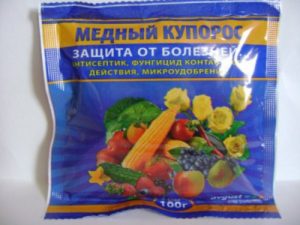
- Bordeaux liquid (copper sulfate + calcium hydroxide, contact fungicide of protective action).
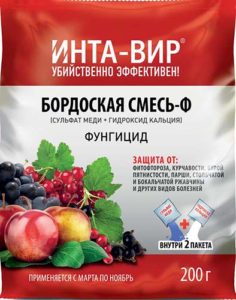
Important! It is believed that copper sulfate, and therefore Bordeaux liquid, inhibits the development of young growth, therefore, these drugs are used for processing only before the leaves appear (after removing the shelter, that is, on a bare vine and when the buds swell).
Based copper oxychloride:
- Abiga-peak (protective contact fungicide);
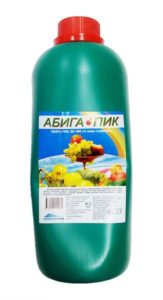
- Hom (protective contact fungicide).
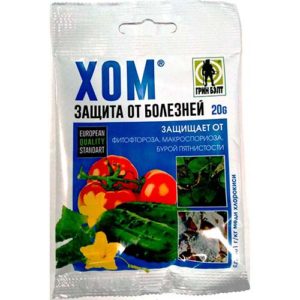
Abiga-peak (400 g / l) and Hom (861 g / kg) are almost analogues.
Based copper hydroxide:
- Coside 2000 (protective contact fungicide).
Biological agents
Recently, the use of biological products has become popular to combat various fungal diseases. But experienced growers advise to carry out treatments with such means only for preventive purposes or after the formation of sufficiently large berries (larger than a pea).
The biological agents for the prevention and treatment of grape mildew include (the active substance and the nature of the drug's effect are indicated in brackets):
- Alirin-B (Bacillus subtilis, strain B-10 VIZR, systemic contact fungicide of protective and therapeutic action);
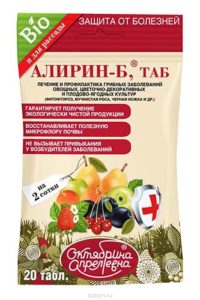
- Baxis (Bacillus subtilis strain 63-Z, protective and curing fungicide);
- Vitaplan (Bacillus subtilis strain VKM-B-2604D and VKM-V-2605D, a protective fungicide against mildew and oidium);
- Planriz (Pseudomonas fluorescens strain AP-33, contact fungicide);
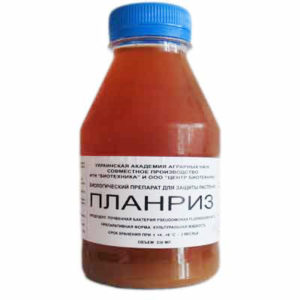
- Rizoplan (Pseudomonas fluorescens strain AP-33, contact fungicide);
Planriz and Rizoplan are complete analogues.
- Sporobacterin (Bacillus subtilis and Trichoderma viride, strain 4097, systemic contact fungicide of protective and therapeutic action);
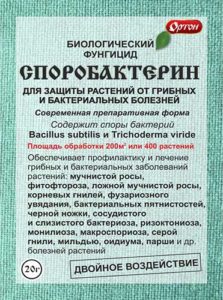
- Fitosporin (Bacillus subtilis strain 26 D, systemic fungicide of protective and curative action);
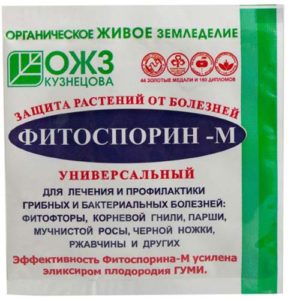
- Gaupsin (two strains of soil bacteria Pseudomonas aureofaciens, complex action insectofungicide).
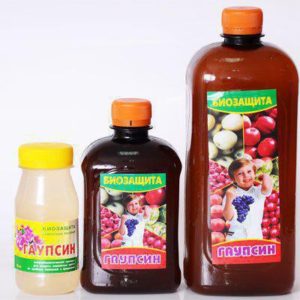
Also, against mildew should be effective Pentaphagus, Trichophyte, Trichodermin and other drugs based on Bacillus subtilis (hay stick).
Folk remedies
Note! Despite the fact that folk remedies are suitable for the treatment of grapes from mildew precisely during the period of fruiting (filling and ripening of berries), nevertheless, their effectiveness is quite low compared to chemical and even bio-preparations.
Wood ash
Ash extract for the treatment of grape bushes from powdery mildew is prepared as follows: 400 grams of wood ash is poured into a bucket of water and stirred well, then infused for 1-2 days. Before spraying, 3 tbsp is added per 10 liters of the resulting solution. spoons (40-50 gr) of laundry or green soap. And don't forget to strain.
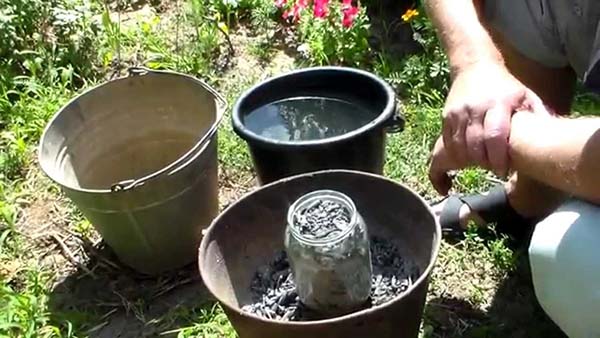
Video: processing grapes with an extract of ash from mildew
Soda
A truly folk remedy for combating powdery mildew on grapes is to prepare a soda solution.
Recipe: 40-50 grams of soda ash per 10 liters of water + 40-50 grams of grated household or green soap can be added.
By the way! The same (like the previous, ash) solution can be used against oidium grapes.
Whey, sour milk and other acidic products
Another safe way to control powdery mildew on grapes is to spray it with whey or sour milk.
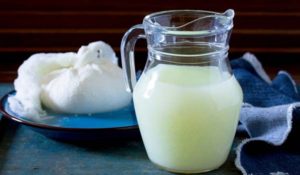
Infusion horsetail... Recipe: Boil 100 grams of dry horsetail per 5 liters of water, let it brew for 12 hours, add 40-50 grams of laundry or green soap.
Infusion fermented sour bread... Recipe: 1 kg of dry crusts per 10 liters of water, 1-2 tbsp. tablespoons of sugar for better fermentation, let it brew for 3-5 days.
The essence of the applicationacidic (horsetail, whey) and alkaline (soda, wood ash) solutions in the fact that neutral acidity is most favorable for the fungus, while an increase or decrease in acidity should cause its death.
Mature hay
A full bucket of rotten hay is filled, filled with water and infused for about 4-7 days in a warm place. During this time, the mixture forms hay stick, which, when spraying, should "gobble up" the fungus, but first the infusion must be diluted with water in a ratio of 1 to 3.
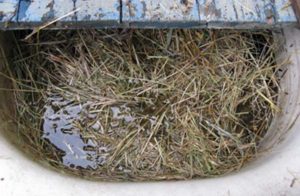
Dill
Some summer residents believe that if you plant next to grapes dill (along the perimeter), this will partially help protect the bushes from the fungal disease in question, but again, you should not rely heavily on such a folk trick.
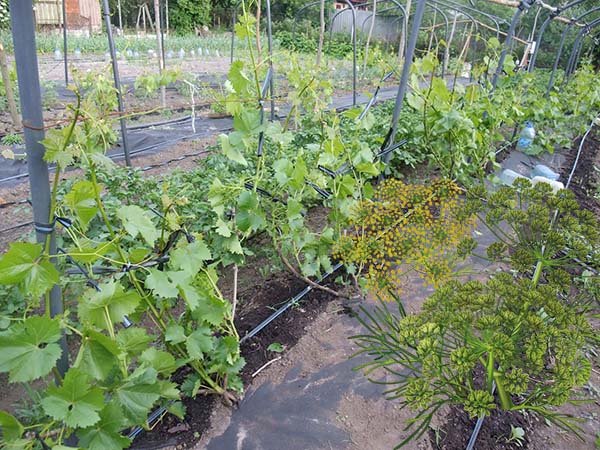
That, even the most pessimistic wine grower will be able to cure his grapes from mildew, if he uses the entire arsenal of chemical, biological and folk remedies to combat this serious and dangerous fungal disease.
Video: grape mildew - description and development of the disease, methods of struggle (fungicidal preparations and folk remedies)

